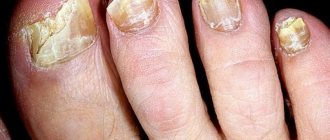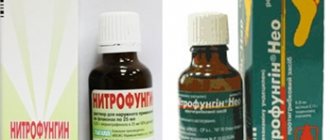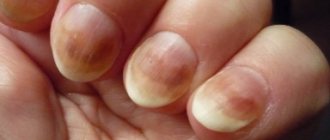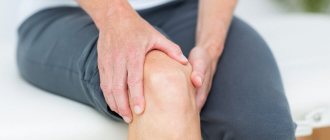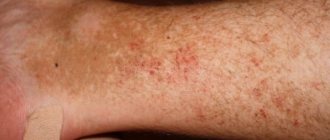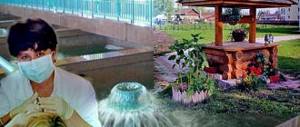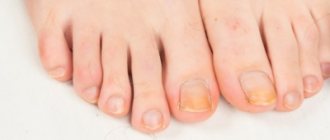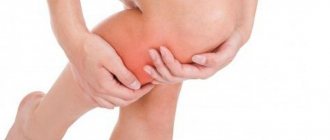Causes of onychogryphosis
Onychogryphosis is always associated with a malnutrition of the nail
It should be immediately clarified that the exact mechanism and causes of the development of this pathology are not precisely known. We can only list the factors that provoke the appearance of onychogryphosis. Almost all of these factors are in one way or another associated with impaired trophism (blood supply, nutrition) of the nail plate.
This could be tight shoes, severe bruises, or an unprofessional pedicure.
In addition, any serious disease of the skin or blood vessels of the lower limb can potentially contribute to the development of onychogryphosis: frostbite, diabetes (primarily occurs with diabetic foot), varicose veins, thrombophlebitis and phlebothrombosis, elephantiasis, etc.
A hereditary tendency to this type of manifestation of nail trophic disorder is also among the predisposing factors, but it is not so often possible to find a family tree of at least two relatives with onychogryphosis.
You should not assume that such a condition cannot threaten you because your relatives do not have it.
Onychogryphosis can be a symptom of severe mycoses and psoriasis of the nail. In this case, the trophism of the nail is also disrupted, but detachment does not occur due to individual characteristics - the nail thickens and grows.
Reasons for the development of pathology (photo)
Nail psoriasis Nail fungus Elephantiasis Varicose veins of the legs Bruised big toe Tight shoes
The influence of trauma and occlusion on the pathogenesis of onychomycosis
| Nail injury | Destroying the barrier to infection | Foot occlusion |
| Direct destruction of the nail plate → | Maceration of surrounding skin | |
| Onycholysis → | Maintaining onycholysis | |
| Increased concentration of carbon dioxide | ||
| Favorable conditions for fungal growth | Temperature and humidity | |
| Hemorrhages and cracks with the formation of channels and cavities → | Suitable niche (conductor →infection to the leg) | |
| ONYCHOMYCOSIS |
Description and features of the pathological condition
Onychogryphosis can be early and advanced
Onychogryphosis has certain stages, during which the nail turns from normal to griffin. First, the nail thickens, then its color gradually changes: normal - yellow - yellow-brown - dark (even black).
After some time, the nail rises above the nail bed, forming a “bird” bend.
Accordingly, it is customary to distinguish the early and late stages of the process.
At a later stage, the nail is already twisted, thickened and hard. Various stripes are visible on it. Trimming a nail becomes extremely difficult. There are problems with wearing shoes, not to mention socks or tights.
Diagnosis of onychogryphosis and search for the underlying pathology
Identifying the root cause cannot be done without consulting a doctor.
When a dermatologist sees onychogryphosis, he first tries to determine the disease that led to this condition.
The patient is interviewed and examined. Be sure to check whether there have been injuries, whether the shoes are too tight, and whether there are endocrinological diseases.
The doctor records the presence of varicose veins, heart failure and other predisposing diseases and conditions.
The following tests are required:
Blood sugar test to rule out diabetes. The point is that with increased fragility of blood vessels, the trophism of the nail is disrupted much more often, i.e. onychogryphosis in diabetics is a fairly common phenomenon; Wasserman reaction to exclude syphilis. The consequences of secondary (i.e., undertreated or untreated) syphilis can also manifest themselves in this way; Scraping for fungal culture. Onychogryphosis may simply be an extreme degree of onychomycosis. In this situation, the malnutrition of the nail occurred due to an advanced fungal infection. As a rule, such situations are associated not only with the lack of timely treatment, but also with severe immunodeficiency.
Treatment of onychogryphosis
Keratolytic patch helps reduce nail thickness
It begins with eliminating the cause that affects the trophism of the nail. Insulin is selected for diabetics, fungus is treated, tight shoes are thrown away.
Only a doctor can adequately treat this condition, since the causes and characteristics of this condition differ each time. In some cases, you may need to consult an endocrinologist, vascular surgeon, cardiologist and a number of other specialists.
One of the main objectives of the therapy is to soften and reduce the thickness of the nail.
In parallel with the treatment of the suspected cause of onychogryphosis, daily steaming of the nail is performed with the application of keratolytic patches and other substances that soften the nail.
In severe cases, the nail will have to be removed, but this is much safer than living with the disease
In severe situations, the toenail can be completely removed with curettage of the matrix.
If onychogryphosis affects the fingers, radical removal is rarely performed. Most often, onycholysin is used to soften the nail plate.
To do this, the powder is diluted to a paste-like state and applied to the affected nail for 30-40 minutes. Without waiting for complete drying, the product is scraped off along with the softened part of the nail plate. In total, up to 3 such procedures are carried out.
In addition, vitamins, minerals, retinol and tocopherol preparations are taken in parallel. Microelements include zinc, calcium, silicon and selenium.
Traditional methods of treatment
They are auxiliary, do not cancel the dermatologist’s prescriptions, and almost never affect the cause of onychogryphosis.
Nail baths can be used as an auxiliary option
Kombucha compress.
The nail is pre-steamed in hot water with the addition of a few drops of iodine. The mushroom, cleared of the film, is fixed with a bandage to the sore nail overnight. The compress is applied every night for a month.
Helps with onychogryphosis caused by fungal infection, somewhat less effective with psoriasis. In other cases, the effect is expressed only in a slight softening of the surface layer of the changed nail.
Aloe compress stimulates tissue repair
A mixture of lavender oil and tea tree oil.
After steaming in a soda bath, apply 2 drops of a mixture of these oils to the nail, rub in and apply a patch. The procedure is carried out within 2 months.
It makes sense in a complex of restoration measures when the condition of the nail has already stabilized. Indeed, during this period it is advisable to nourish the matrix and the plate itself with essential oils.
Aloe juice in the form of a compress.
The pulp of the fleshy (lower) leaves is used, it is crushed into a pulp, which is applied to the affected nail. We fix it with a cotton swab of polyethylene and secure it with bandages. The procedure is performed at night for a month.
The compress has a stimulating effect, accelerates tissue regeneration, and also prevents the development of fungal and bacterial infections.
Systemic drugs
For large fungal infections, external therapy alone is not enough. In such cases, systemic antifungal drugs .
| Means | Dosage | Multiplicity |
Itraconazole | 200 mg | 2 times a day for 3-4 months |
Ketoconazole | 400 mg | 2 tablets on the first day, then 1 tablet until the plate grows back |
Terbinafine | 250 mg | 1 time per day for 3-4 months |
Fluconazole | 150 mg | 1 time per week until the plate grows |
All systemic drugs have a toxic effect on the liver, so before prescribing them, it is always recommended to examine a therapist and conduct liver tests. When transaminase levels deviate from normal, as well as in a number of chronic diseases, systemic drugs are contraindicated.
Prevention and general recommendations
Onychogryphosis occurs when several provoking factors coincide, so try to minimize the risk of this phenomenon:
Never wear tight shoes; Take the treatment of any vascular pathologies and diabetes seriously; Pay attention to the thickening of the nail plate. At the first problem with cutting your nails, immediately contact a dermatologist.
If you follow these recommendations, you will not only be able to preserve your nails, but also prevent the development of previously unknown diseases and conditions.
About the authorBecome an author
General practitioner at a city clinic. Eight years ago I graduated from Tver State Medical University with honors.
More details
Are you tormented by a fungus? But if you want to get rid of it, and the unpleasant odor and itching too, read what the Ministry of Health recommends Read more...
Onychogryphosis on toenails
The diagnosis of “onychogryphosis” hides an unpleasant nail disease associated with their deformation due to various factors. A healthy plate has a smooth surface or a slight convexity. When pathology occurs, it noticeably thickens and the natural shape and shade changes. This nail resembles the claw of a bird of prey. In addition to its unaesthetic appearance, it causes painful sensations when it grows into the skin and twists in a spiral.
Literature
- Petrova G. A. Fungal diseases of the skin and nails. Prevention and treatment methods / Galina Petrova. - M.: Tsentrpoligraf, 2004. - 95 p. ; 17 cm - (Family doctor)
- External therapy of foot mycoses. manual for doctors /National. acad. mycology, All-Russian. society org.; [Sergeev Yu.V. et al.]. — Moscow: Nat. acad. mycology, 2005. - 24 p. : ill., table. ; 21 cm. - Bibliography: p. 24
- Sergeev A. Yu. Fungal diseases of nails /A. Yu. Sergeev. — M.: Medicine for all National. acad. mycology, 2001. - 156, [2] p. : ill. ; 21 cm. - Bibliography. at the end of the book.
Symptoms of pathology
Advanced onychogryphosis
Most often, the deformity occurs on the nails of the big toes. The first sign is pain in the soft tissues under the nail plate, severe discomfort while wearing any shoes. Unpleasant sensations intensify with the slightest pressure.
Gradually, the plate thickens and begins to resemble an unnatural horny growth. The density becomes so strong that it can be shortened only after pre-treatment and softening. The color changes to yellow-brown, sometimes turns gray, and there may even be pus under the nails.
Experts define two main stages of onychogryphosis:
Early: symptoms are expressed in the elevation of the nail above the soft bed, darkening. Patients note a curvature of the plate and often experience painful ingrowth into the skin. Late: the nails are twisted and resemble a bird’s claw with their non-standard shape. With the naked eye you can notice the appearance of deep longitudinal or transverse stripes. At home, it becomes difficult to remove the length of such a growth, so it is difficult for a person to move even in comfortable shoes, and the quality of life deteriorates.
By contacting a specialist for full treatment at an early stage, you can prevent many problems and complications.
Main reasons
The development of onychogryphosis on the nails is often experienced by older people, but under certain factors it occurs in children and young people. At risk are lovers of fashionable pointed shoes and professional athletes.
Experts identify several main reasons for such deformation:
Severe finger injury that resulted in damage. Impaired blood supply to soft tissues and nutrition of the nail plate due to compression by tight shoes or unprofessional pedicure. Endocrine system disorder. Heredity. Fungal infection.
The thrush disappeared in 1 day! New remedy for thrush Find out more...
Onychogryphosis on the big toe nail
Often the pathology is a direct consequence of psoriasis, frostbite of the fingers, and varicose veins. Experts are still studying possible factors influencing its occurrence. The only established fact is the obligatory relationship between disruption of the nail nutrition process, which leads to improper growth of the cells that form the plate.
Non-fungal nail diseases
Non-fungal diseases are caused by other reasons. However, during their course, infection with a fungus often occurs, which aggravates the clinical picture and delays the patient’s recovery process.
Melanonychia
The pathology is characterized by the deposition of melanin in the nail structure. Usually complements some other disease. Causes include fungal infections, prolonged contact with solutions based on potassium permanganate, chronic injuries, wearing uncomfortable shoes, and inflammatory diseases.
Longitudinal stripes appear on the nail. The problem may affect only one finger, or several at once. The color changes - yellowish and cinnamon shades predominate, sometimes black. The big toe is most often affected.
The disease is diagnosed equally often in men and women. People over 55 years of age are at risk. In children, the disease is rarely detected.
During diagnosis, it is imperative to examine the patient for subungual melanoma, a malignant tumor.
Leukonychia
Serious illness. It manifests itself mainly by the appearance of white stripes on the fingernails. Symptoms are always different. Sometimes single signs of the disease appear, that is, the nail plate is affected in a targeted manner. And in some cases, complete damage to the nail is diagnosed.
The etiology is due to the negative influence of external factors - chronic trauma, exposure to chemicals and toxic substances. The impetus for the occurrence can be internal pathologies:
- Slowing down metabolic processes.
- Severe chronic infections.
- Pathologies of the central nervous system.
Contrary to popular belief, mineral and vitamin deficiencies do not lead to the appearance of white spots.
Anonychia
The disease is characterized by the absence of the nail plate. It can be congenital or acquired. In the first case, the clinical picture is complemented by other congenital defects, for example, improper functioning of the sweat glands, changes in hair structure. The disease is inherited.
The acquired form is a consequence of exposure to external factors - injuries. In some cases, they occur due to other nail diseases. A malfunction in the central nervous system may also be the cause.
There is no treatment for this particular pathology. Therapy involves influencing the disease that caused anonychia.
Chromonychia
Painting nails in different shades of yellow. The reasons are varied. Internal and external factors influence. In medicine, false chromonychia is also distinguished. This is when the nail turns yellow due to exposure to chemicals.
There are no specific medications to treat chromonychia. True illness is treated with vitamin and mineral complexes. They allow you to eliminate the problem of yellowness for several months.
Ingrown nail
The main reason is uncomfortable or ill-fitting shoes. The disease most often occurs in older people. Other causes of ingrown toenails:
- Incorrect pedicure;
- Hallux valgus;
- Fungus;
- Genetic predisposition;
- Injuries;
- Bacterial diseases, etc.
The most obvious symptom is pain. It tends to intensify while wearing shoes, sometimes even from a light touch to the nail. The tissues next to the plate become swollen and red, and granulation appears around. With this pathology, the likelihood of infection is high. In severe cases, the body temperature even rises.
Conservative, orthopedic and surgical methods are used for treatment. In the latter case, laser treatment is popular. Removing a nail with a laser is quick, relapse is relatively rare, the rehabilitation period is short, and the reviews are good.
The disadvantage of manipulation is its high cost.
Diagnosis of pathology
Regardless of the cause, onychogryphosis on the fingernails requires systematic treatment. Having noticed the first signs of a change in the shape of the nails, you should consult a podiatrist or dermatologist, who initially conducts a thorough visual examination and clarifies the possible injury.
In addition, the patient is prescribed the following tests:
Blood sampling to identify the causative agent of syphilis (Wassermann reaction), which can provoke a modification of the plate. Measurement of sugar levels, indicating the presence of diabetes mellitus (deformation of nails is not uncommon in this serious disease). Scraping the surface of the nail and the skin around it. This helps to determine the fungal component in the cause of the disease, since onychogryphosis on the toenails can be the extreme stage of a mycotic disease.
If the main factor is heredity, then it is almost impossible to cure it.
Onychogryphosis treatment
Onychogryphosis photo
With onychogryphosis on the nails, many patients turn to specialists in an advanced state, which is difficult to completely cure. Many people simply ignore primary changes in shape and color, self-medicating without a clear diagnosis.
When treating onychogryphosis, the doctor’s actions are aimed at alleviating the patient’s condition, reducing the thickness of the growth and giving the nail the correct shape. To do this, partial or complete removal of the damaged stratum corneum is performed after special treatment. This relieves pain and promotes speedy healing. The choice of method depends entirely on the cause of the disease.
To soften the damaged nail, a special medical composition is used - onycholysin. It is based on barium sulfide and talc in a ratio of 15% and 85%, respectively, and the method of application is quite simple:
the powdered medicine is diluted with water to form a porridge; cover the plate with a layer, leave for 30 - 40 minutes; The product is washed off with warm water, gradually scraping off the softened part.
To completely remove the problematic nail, up to 3 such procedures are required. During therapy, it is mandatory to consume a vitamin complex with a high content of calcium, selenium, zinc, vitamins E and A. This helps to increase the content of useful and nutrient substances that promote the accelerated growth of smooth nails. Ointments can be recommended as external agents:
retinol; ichthyol; containing gelatin.
In severe cases of onychogryphosis on the hands and feet, the doctor completely removes the nails along with the matrix. They try to preserve the base on the fingers so as not to spoil the aesthetics of the appearance.
A good option for painless and high-quality removal is the use of a laser. The procedure itself takes place under local anesthesia and takes several minutes. Given minimal surgical intervention, complete healing is possible within two weeks.
Onychogryphosis treatment with folk remedies
It is impossible to completely cure onychogryphosis on the nails using simple traditional medicine methods, but this can alleviate the patient’s condition and speed up healing. The most effective ways are:
Compresses with kombucha: first steam the feet in hot water with the addition of iodine or sea salt. A cleaned and washed piece of kombucha is placed on the nail, secured with a bandage and left overnight. This procedure must be carried out every evening for four weeks. Use of essential oils: mix equal amounts of tea tree oil and fragrant lavender. After preliminary steaming, a few drops of the mixture are applied to the nail plate and covered with a thin plaster. This treatment is carried out for at least 2 months and is more effective for fungal pathogens.
Types of onychodystrophy and symptoms
Since the causes of the disease are varied, its manifestations are also varied. Onychodystrophy is divided into separate types, each of which has its own symptoms.
The main types are described below.
Beau Reil's groove (Beau's groove)
They are transverse grooves that cross the surface of the nail plates. The lines stretch from one side roller to the other. This pathology is one of the most common.
The severity of damage to the nail matrices is assessed by the depth of Bo's furrows. In mild cases, the line is superficial, but in severe cases it is deep and can divide the thickness of the nail plate into two halves. Under such conditions, the removed part of the plate over time loses contact with the nail bed, turns white and separates.
When the matrix is periodically damaged, several grooves appear. They are located one after another, creating a wavy surface.
Longitudinal furrows
Like transverse ones, they can be single (mainly in the central part of the plate), or in large numbers. This is the main manifestation of longitudinal grooves. In the second case, the entire surface of the nail is occupied by lines.
Onychodystrophy of nails in children most often manifests itself in the two types described above (as a consequence of measles, viral diseases).
Brittle nails
Refers to a common type of dystrophy, occurring mostly in women. Most often the free edge of the nail plate breaks.
Separation occurs completely or only the top layer is destroyed, leaving a torn, fringe-like edge.
Orichorrhexis
The nail splits in the longitudinal direction. This pathology appears mainly in older people.
Onychoschisis
Wedging of the nail occurs transversely. A feature of this type of dystrophy is the normal growth of the nail plate to the free edge. This is followed by splitting into two, three layers or more. The nail either breaks off or continues to grow in the form of several thinned plates.
Onycholysis
The solid nail plate loses connection with the bed. Rejection begins at the exposed edge and eventually spreads toward the nail hole. Usually no more than half of the nail plate is separated. The lagging part remains smooth, but already whitish-gray in color. An exception is onycholysis of fungal or bacterial origin, in which the plates become deformed and their color changes.
Onychomadesis
The entire nail plate is also separated, but the rejection begins from the proximal part of the nail - opposite the free edge. This type of onychodystrophy is much less common than the previous one. It is pronounced and may be accompanied by inflammatory and painful reactions. The big toes and toes are more often susceptible to rejection.
Punctate (or thimble-shaped) wear
It manifests itself by the appearance of small dents on the surface of the nail plate, like a thimble. The number of pits varies widely. Their depth can be slight (for example, with eczema) or deep (syphilis, psoriasis).
Koilonychia
A depression is formed like a saucer, spoon or bowl. The nail plate, as a rule, remains smooth and of standard thickness. The depression mainly appears on the 2nd and 3rd fingers of the hands.
Senile nails
The nail becomes dull, grayish or yellowish. Longitudinal grooves appear; with age, their number and depth increase.
Onychogryphosis
The nails thicken significantly, hypertrophy, bend and become excessively hard. The color of the nail plate changes to yellow, dirty brown or almost black. Mainly individual nail plates of the feet are affected.
Hippocrates nails
The disease is characterized by a change in the shape of the nail plate, which becomes dome-shaped, and its hardness is often lost. The fingertips become rounded and over time take on the appearance of drumsticks.
Nail deformation is diagnosed by external examination and certain tests. When this disease is suspected, it is necessary to find out whether there have been injuries to the limbs or possibly other injuries that injure the nail plate. A number of tests that need to be taken:
- blood for sugar, because diabetes mellitus may be accompanied by a change in the appearance of the nails;
- blood for RW to exclude syphilis;
- an analysis that determines fungal infection of the nail - for this, a scraping from the site of the diseased nail is analyzed or a part of the nail plate is taken. The taken material is carefully examined under a microscope and the fungi that provoked the disease are discovered.
Onychogryphosis is extremely difficult to treat, so it is better to prevent its development. This can be done by following simple preventive measures.
Helps to keep your nails healthy:
- wearing shoes that do not squeeze your toes and are of a suitable size;
- therapy of major diseases (diabetes mellitus, varicose veins and others);
- balanced diet;
- use of gloves when in contact with aggressive chemical compounds;
- proper manicure (pedicure), without cutting the corners of the nails;
- precautions when visiting swimming pools or saunas to prevent the possibility of fungal infection.
If the disease is congenital, you should regularly see a specialist. This will help stop relapses at the initial stage.
In most cases, it is impossible to completely cure onychogryphosis. A timely visit to a dermatologist allows you to preserve the nail plates without resorting to their complete removal.
Onycholysinum is a mixture of 15 parts barium sulfide and 85 parts talc. Used to remove the nail plate. fungal diseases. Onycholysin powder is mixed with water into a paste-like mass, applied to the nail plate in a layer of up to 0.5 cm, kept moist for 30-40 minutes, then washed off with water. The softened nail is scraped off. To completely remove the nail plate, 1-3 sessions are required. After removing the nail, begin using fungicidal agents. Release form: glass jar of 1 and 0.5 kg. Store onycholysin in a dry place.
See also Keratolytic, keratoplastic agents.
Onycholysinum is a keratolytic agent; a mixture of 15% barium sulfate and 85% talc. When onycholysin is combined with water, an alkali is formed, which softens and partially dissolves the horny substance. Used for onychomycosis. A 0.5 cm layer of onycholysin gruel ground with cold water is applied to the affected nail, the surface of which is often moistened with water. After 30-40 minutes. Onycholysin is washed off and the nail plate is scraped off. When indicated, the procedure is repeated 2-3 times. Onycholysin does not have a therapeutic effect, therefore, after removing the nail plate, antifungal agents are used (see). Release form: powder, keep carefully closed in a dry place. See also Keratolytic, keratoplastic agents.
In order for your nails to always delight you with their beauty, you need to monitor their health. Problematic nails are especially common on the toenails. If the nail is sick, then timely diagnosis of the disease will contribute to more effective and easier treatment. One of these ailments that should not be neglected is onychogryphosis of the nails.
Onychogryphosis is manifested by compaction and twisting of the nail plate. Its development is distinguished by two stages of the disease:
- At the mild stage, the nail thickens and its color changes to gray or yellow. At the same time, it becomes more convex, rising above the nail bed. The nail is difficult to cut due to its increased thickness.
- At a later stage, the deformation becomes more noticeable. Longitudinal and transverse stripes are clearly visible on the surface of the nail. The color changes to brown. The nail becomes strongly twisted and takes on a shape resembling the claw of a large bird. At this stage it is not always possible to cut the nail, so it can grow up to four centimeters in length. This nail causes severe pain and makes it difficult to wear shoes.
Onychogryphosis can be hereditary or acquired. It occurs in people of any age, but most often develops in older people. Usually appears on the nails of the big toes. The causes of its development can be both diseases and injuries. The most common of them:
- endocrine diseases;
- injuries;
- disorders of skin keratinization;
- frostbite of toes;
- fungal nail infections;
- nail psoriasis;
- Wearing tight shoes (can also cause ingrown toenails);
- genetic predisposition;
- elephantiasis of the legs.
To treat onychogryphosis, diagnostics are carried out, which makes it possible to identify concomitant diseases. It is necessary to carefully monitor the appearance of your nails in order to notice the disease as early as possible. If you notice thickening of the nail plates and changes in their color, you should contact a specialist. Such diseases are dealt with by a podiatrist.
When contacting the clinic, the following tests are prescribed to exclude diseases such as:
- diabetes mellitus (blood sugar);
- nail fungus (scraping);
- syphilis (blood on RW).
After diagnosis of onychogryphosis of the nail, treatment is prescribed. Depending on the cause of development, it can be complex. In this case, an additional examination is carried out by an appropriate specialist.
The podiatrist prescribes a set of measures, including the following:
- keratolytic patch;
- onycholysin powder;
- ointments with ichthyol, retinol, gelatin;
- vitamin complexes;
- antibacterial drugs (if pus comes from under the nail).
Drug treatment usually lasts up to four months. In some cases, the disease cannot be cured. In severe cases of the disease, it may be necessary to remove the nail and scrape out its root.
Onychogryphosis reviews
Elena, 42 years old, Krasnograd
My mother has this unpleasant disease, which, due to her character and old age, she does not want to treat. Her nails are in such a terrible and unkempt state that she really can’t put on her shoes. It’s okay, it’s summer and you can walk around in slippers, scaring your grandchildren, but it’s cold, and you really can’t fit into your shoes. She stubbornly refuses to go to the doctor; she has only one argument – “what can they do there?” In short, I surfed the Internet, read advice and decided to steam my feet in soda and anoint them with fir oil. Onychogryphosis on the toenails began to gradually disappear. The nails became softer and easier to handle. Then, a doctor I knew recommended ichthyol ointment, which really helped. They applied it for six or seven months, and my mother’s nails have been in normal (for her age) condition for 2 years now. They advised me to have an operation to remove the diseased nails from the roots, but I was afraid that my mother would not survive this nightmare. Thank God that everything ended well. All the best and health.
Lika, 23 years old
My mom has similar nails to the photos above. She is 53 years old and she categorically refuses to go to a specialist. And I really see that the nails look like the claws of a scary bird. In reality, the nails on the thumbs have become about two centimeters long from the edge of the finger and are tightly curled. Friends recommend antifungal ointments, but they are expensive and I’m not sure if it will really help. For two weeks in a row we did ether baths based on fir. After treatment, the nails became similar to normal, but I am afraid that the problem is deeper and the disease will return again.
Gregory, 36 years old
Once upon a time my dad had a similar infection. Real advice on how to treat this onychogryphosis: Take equal proportions of fir tree oil and lavender oil (all are freely sold in pharmacies). Then, mix it all and rub it into the affected nail plate. You need to steam your feet in soda or potassium permanganate in advance. Carry out all manipulations until a healthy nail plate grows. Don't thank me.
Pathogenesis of mycosis of nails
Most often, the fungus enters the nail from infected skin.
But if a pedicure was performed with infected instruments, the parasite can penetrate directly into the nail plate.
After the fungus enters the nail bed, it responds by increasing the proliferation of its cells. As a result, the stratum corneum at the edge of the nail bed thickens, its connection with the nail plate is weakened, and it is separated from the nail bed, i.e. A void appears between the nail and the skin. This is called onycholysis (onyho - nail, lysis - untying, separation).
From the nail bed, the fungus sends out its “tentacles” further from the point of penetration. If it gets into the nail from the distal or lateral ridges, then its path lies in the holy of holies - to the matrix, where the growth cells are located.
Apparently, his favorite delicacy there - keratin protein - is tastier, more tender, juicier.
Over time, he, like Hitler’s troops, captures more and more new territories. His gluttony knows no bounds: the nail bed is not enough for him, give him the nail plate itself.
And now spots, stripes, and roughness appear on it, and it itself becomes either too thick, or, on the contrary, so thin that its edges crumble and break.
If at this stage you do not deploy troops against the fungus, it will reach the growth zone, and then the new nail will grow already affected and ugly. Total onychomycosis develops when the entire nail is completely eaten by the fungus.
With candidiasis, the tactics of the parasitic fungus are different. First, it causes inflammation of the proximal cushion - felon.
It looks like swelling, thickening at the base of the nail. After some time, the cuticle separates from the nail plate. Fungi enter the nail matrix, and then into the plate and bed, gradually separating them from each other. That is, the lesion here will not come from the free edge of the nail, but from below, from the growth zone.
The same thing happens when infected with mold fungi.
Nail removal for onychogryphosis (+18)
Doctors warn! Skin problems, constant rashes of unknown nature, this means that your body is signaling the presence of parasites. Parasites in the body weaken the immune system, poisoning a person with poisons... In order to eliminate skin problems, it is necessary to cleanse the body of parasites and toxins released by them. A country-famous doctor spoke about a new effective remedy against parasites... Find out how to get rid of parasites once and for all with the help of a new natural remedy >>>...

